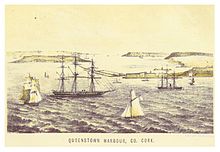The Commander-in-Chief, Coast of Ireland was both an admiral's post and a naval formation of the Royal Navy. It was based at Queenstown, now Cobh, in Ireland from 1793 to 1919. The admiral's headquarters was at Admiralty House, Cobh.[1]
| Commander-in-Chief, Coast of Ireland | |
|---|---|
 Queenstown harbour in 1871 | |
| Active | 1793–1922 |
| Allegiance | |
| Branch | |
| Garrison/HQ | Cobh (known as Queenstown between 1849 and 1922) |
History
editThe French Revolutionary Wars led to Cobh, then usually known as Ballyvoloon or The Cove of Cork, being developed as a British naval port, and assigned an admiral. The first appointment of an "Admiral Commanding in Ireland" or "Commander-in-Chief, Cork" was in 1793.[2] The post remained unfilled between 1831 and 1843.[2] It was renamed "Commander-in-Chief, Queenstown" in 1849 following a visit by Queen Victoria during which she renamed the town of Cobh "Queenstown".[3]
The post became "Senior Officer on the Coast of Ireland" in 1876. The full title of the incumbent following the establishment of the post of Admiral Commanding, Coastguard and Reserves in 1903 was Senior Officer on the Coast of Ireland and Deputy to the Admiral Commanding Coastguard and Reserves for Coastguard Duty in Ireland.[4]
In July 1915, not without misgivings in some quarters, Vice-Admiral Lewis Bayly was appointed to the post.[5] Bayly was tasked with keeping the approaches to Britain safe from U-boat attacks. In 1917, Bayly, promoted to admiral and given the title Commander-in-Chief, Coast of Ireland, was given command of a mixed British-American force defending the Western Approaches. He took as his chief of staff the American captain Joel R. P. Pringle. Bayly had a good working relation with his U.S. counterpart William Sims. He held this post until 1919.[6]
The post became "Commander in Chief, Western Approaches" in 1919, and was disestablished at the end of the Irish War of Independence in 1922. That year the town reverted to the name Cobh. The Royal Navy continued to station ships in Ireland, in accordance with the Anglo-Irish Treaty until 1938.[2] After Ireland's independence, the Royal Navy presence generally consisted of two destroyers, with one usually anchored in the Cobh roadstead, opposite Haulbowline, and another either on roving patrol, or moored at Berehaven. These 'guard ships' were withdrawn and the harbour forts (probably including Fort Westmoreland, Fort Carlisle, and Fort Camden (Crosshaven[7][8]) were handed over to the Irish Government in 1938.[9]
Commanders
editCommanders included:[10]
= died in post
Commander-in-Chief, Cork
edit- Vice-Admiral Phillips Cosby (1790–1793)
- Vice-Admiral Robert Kingsmill (1793-1800)
- Vice-Admiral Lord Gardner (1800-1802)
- Commodore William Domett (1802–1803)
- Vice-Admiral Lord Gardner (1803–1805)
- Rear-Admiral William O'Bryen Drury (1805–1807)
- Vice-Admiral James Hawkins-Whitshed (1807-1810)
- Vice-Admiral Edward Thornbrough (1810-1813)
- Vice-Admiral Herbert Sawyer (1813-1815)
- Rear-Admiral Benjamin Hallowell (1816-1818)
- Rear-Admiral Josias Rowley (1818-1821)
- Rear-Admiral Lord Colville (1821-1825)
- Vice-Admiral Robert Plampin (1825-1828)
Commander-in-Chief on the coast of Ireland
edit- Rear-Admiral Charles Paget (March 1828 – 1831)[11]
- Commodore Sir Edward Troubridge (1831–1832)
Commander-in-Chief, Cobh
edit- Rear-Admiral Hugh Pigot (1844-1847)[12]
- Rear-Admiral Thomas Ussher (1847-1848)
Commander-in-Chief, Queenstown
edit- Rear-Admiral Donald Mackay (1848-1850)
- Rear-Admiral Manley Dixon (1850-1852)
- Rear-Admiral John Purvis (1852-1855)
- Rear-Admiral George Sartorius (1855-1856)
- Rear-Admiral Henry Chads (1856-1858)
- Rear-Admiral Charles Talbot (1858-1862)
- Rear-Admiral Sir Lewis Jones (1862-1865)
- Vice-Admiral Charles Frederick (1865-1867)
- Rear-Admiral Claude Buckle (1867-1868)
- Rear-Admiral Frederick Warden (1868-1869)
- Rear-Admiral Arthur Forbes (1869-1871)
- Rear-Admiral Edmund Heathcote (1871-1874)
- Rear-Admiral Robert Coote (1874-1876)
Senior Officer on the Coast of Ireland
edit- Rear-Admiral Henry Hillyar (1876-1878)
- Vice-Admiral William Dowell (1878-1880)
- Rear-Admiral Richard Hamilton (1880-1883)
- Rear-Admiral Thomas Lethbridge (1883-1885)
- Rear-Admiral Henry Hickley (1885-1886)
- Rear-Admiral Walter Carpenter (1887-1888)
- Rear-Admiral James Erskine (1888-1892)
- Rear-Admiral Henry St John (1892-1895)
- Rear-Admiral Claude Buckle (1895-1898)
- Rear-Admiral Atwell Lake (1898-1901)
- Vice-Admiral Edmund Jeffreys (1901-1904)
- Vice-Admiral Angus MacLeod (1904-1906)
- Rear-Admiral Sir George King-Hall (1906-1908)
- Rear-Admiral Sir Alfred Paget (1908-1911)
- Vice-Admiral Sir Charles Coke (1911-1915)
Commander-in-Chief, Coast of Ireland
edit- Admiral Sir Lewis Bayly (1915-1919) (title changed from Senior Officer, Coast of Ireland, to Commander-in-Chief, Coast of Ireland on 4 June 1917)[13]
Commander-in-Chief, Western Approaches
edit- Admiral Sir Reginald Tupper (1919-1921)
- Admiral Sir Ernest Gaunt (1921-1922)
References
edit- ^ Halpern, Paul G. (1995). A Naval History of World War I. Routledge. p. 359. ISBN 978-1857284980.
- ^ a b c "The Royal Navy in Cork, Ireland". Cork Ship Wrecks. Archived from the original on 2018-08-02. Retrieved 7 January 2020.
- ^ "Historic Cobh". Ask about Ireland. Retrieved 27 December 2014.
- ^ "Coast of Ireland". Dreadnought Project. Retrieved 3 October 2020.
- ^ Massie, Robert K. (2003). Castles of Steel: Britain, Germany, and the Winning of the Great War at Sea. Random House. ISBN 0-679-45671-6.
- ^ "No. 31433". The London Gazette. 4 July 1919. p. 8390.
- ^ Paul M. Kerrigan (1995). Castles and fortifications in Ireland, 1485–1945. Collins Press. pp. 136 & 193. ISBN 1898256128.
- ^ "Notes on the History of Haulbowline". The Irish Sword. VII. Military History Society of Ireland: 30. 1965.
- ^ "Cork Forts Handed Over". The Times. 12 July 1938.
- ^ "Senior Royal Navy appointments" (PDF). Archived from the original (PDF) on 15 March 2012. Retrieved 27 December 2014.. Amend made from Dreadnought Project to Sir Lewis Bayly
- ^ The Gentleman's Magazine 1839, p 657-8, accessed 28 October 2007
- ^ Harrison, Simon. "Commander-in-Chief at Cobh". threedecks.org. S. Harrison, 2010-2018. Retrieved 14 June 2018.
- ^ Dreadnought Project - ADM 196/38 f. 84